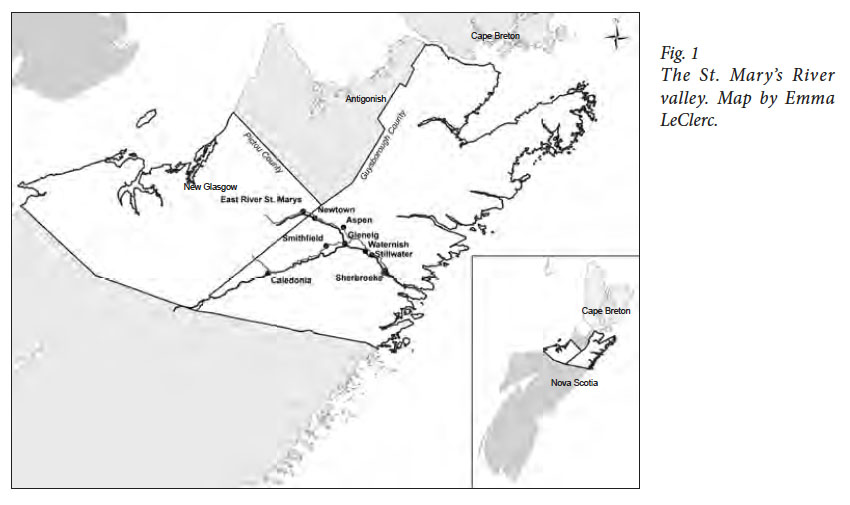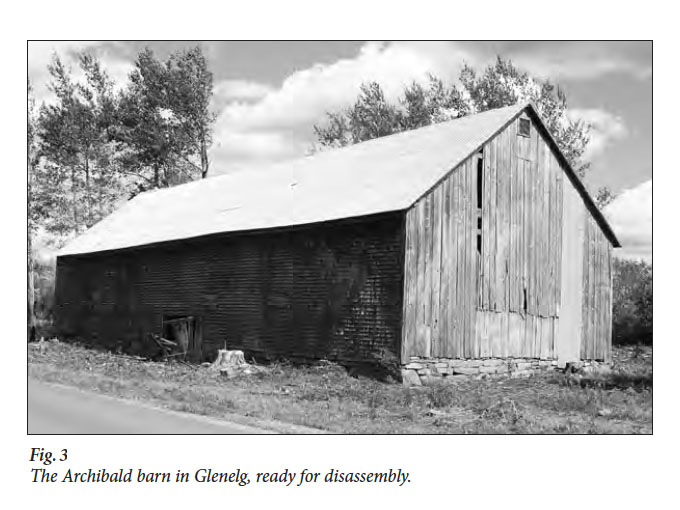Research Reports
Beyond Preservation:
A Consideration of the Intangible Aspects of Buildings
1 First settled in 1800 by second–generation New England planters and immigrant Scots, the St. Mary’s River valley is a rural region that extends through Pictou and Guysborough counties in Northeastern Nova Scotia (Fig. 1). From the flat, rich intervales that touch the river, farms rise in a gentle upland slope of grassy fields and pasture to the thick woodlot beyond. With the barn snug against a bank and the house set atop a small hill, many 19th-century farmsteads still proudly overlook the road that cuts the valley and winds along the river to the town of Sherbrooke, where the freshwater meets the Atlantic Ocean.
2 The Cunningham farm in the community of East River St. Mary’s is one such place. The house was built following a side-hall plan that was a common choice throughout the valley (Fig. 2). Recently retired, Jamie Cunningham is in the process of renovating his house, adding to the multiplicity of layers of change that have been carried out on the house over the decades since initial construction by McConnchie Gunn, ca. 1873. Jamie’s alterations have included both efficiency and cosmetic work: spray foam insulation in the fieldstone cellar, insulated chimneys, a red steel roof, polished oak hardwood flooring in the hall and dining room, and new kitchen cabinetry. The house retains the majority of its original six panes over six panes windows, all in pristine condition. One recent autumn, Jamie informed me that he had removed one of the original upstairs bedroom windows and replaced it with a vinyl one pane over one pane window. He told me I would hardly be able to tell the difference because of the vinyl muntins that created the illusion of multiple panes. I could notice, of course, and was disappointed by the alteration. He removed the window, he told me, because the panes frosted in the morning and he and his wife could not see out over their yard when they woke up.
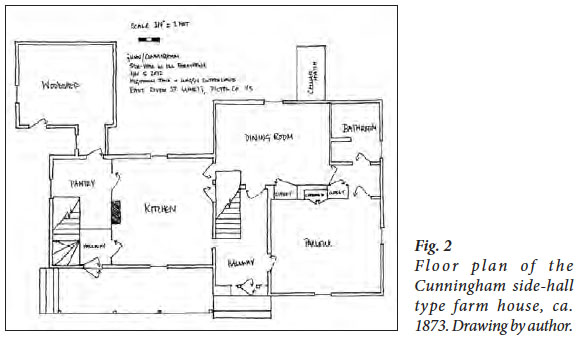 Display large image of Figure 2
Display large image of Figure 2
3 In the summer of 2011, the Elwyn Archibald barn in the community of Glenelg was disassembled and sold to an antiques and architectural salvage dealer, and the large timber frame has been subsequently resurrected as a pool house for a wealthy homeowner outside of Berwick, in the Annapolis Valley of Nova Scotia (Fig. 3 and 4). The date of the construction of the barn is unknown, but it was certainly raised before the 1870s. Similarly, the Gunn farmhouse in East River St. Mary’s, probably built sometime in the 1880s, was demolished in 2015 (Fig. 5). In a previous era, it was one of the finest houses in the region, but it had not been lived in since the early 2000s. The house had been let to fall into disrepair, and the Gunn family increasingly saw it as an embarrassing eyesore on the landscape. Discussion about tearing it down had been ongoing for some years, and it was just a matter of when, not if, the house would go.
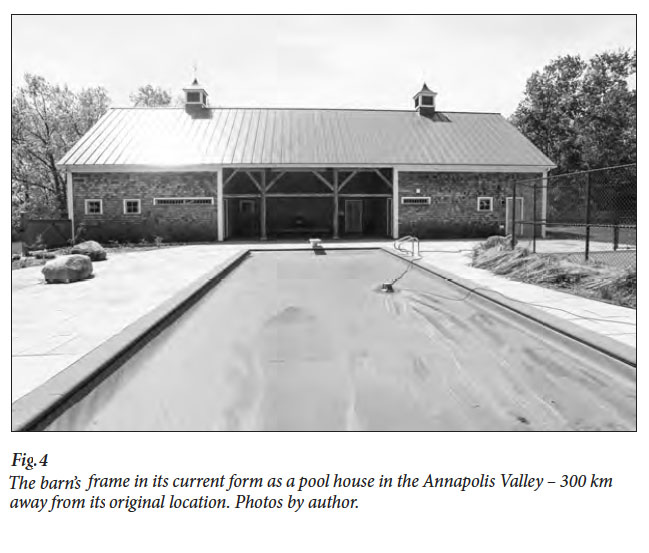 Display large image of Figure 4
Display large image of Figure 4
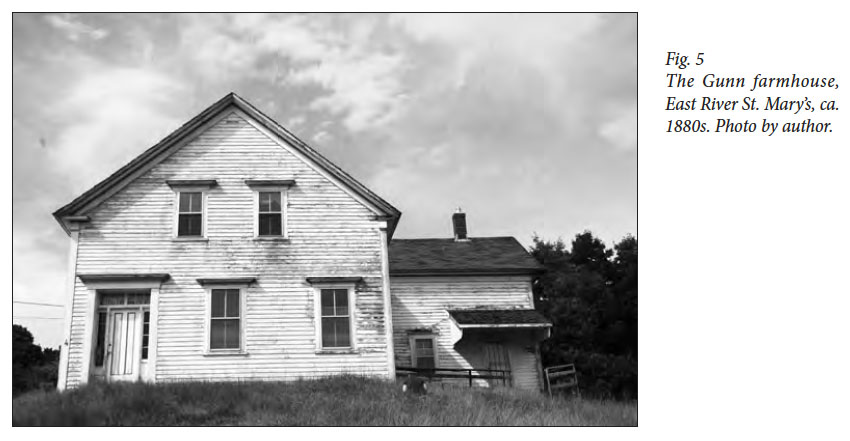 Display large image of Figure 5
Display large image of Figure 5
4 I felt frustration about the removal of these important buildings and their features from the rural landscape that I grew up in. This was because I had come to study the farm architecture of the St. Mary’s River valley with a range of assumptions about old buildings and what constitutes “heritage.” The intent of my research on the built landscape of St. Mary’s is to analyze the architecture as a material manifestation of the culture and ideas of a specific time and place: farming in 19th-century Nova Scotia. But as my field survey progressed, I frequently found myself passing aesthetic—even moral—judgment on my fellow community members concerning the way historic buildings are viewed and treated. I perceived a lack of initiative from my neighbours to be “good” stewards of the past.
5 In her exceptional study, Uses of Heritage (2006), Laurajane Smith argues that heritage is framed within an authorized discourse that is perpetuated by professionals and academics generally of an upper social and educational class, which works to naturalize a range of assumptions about the nature and meaning of heritage. Smith argues that the authorized heritage discourse works to construct a sense of what heritage is, and what it is not. In other words, the authorized discourse privileges expert values and knowledge about the past and its material manifestations, which then dominates and regulates professional heritage practices. When applied to built heritage, the discourse generally maintains the view that the authenticity and value of the heritage lies in the materiality of the architectural structure, and in the integrity of the fabric of the object. Thus the heritage specialist’s ethic of material preservation becomes the most appropriate value when dealing with old buildings. Indeed, in most heritage preservation strategies it is the building stock that gets safeguarded, but not the wider, intangible contexts of the community or neighbourhood in which the building is found. In the case of a community like St. Mary’s, these intangible contexts concern rural sustainability, such as the prospect to live and work in the place you are from.
6 Cultural institutions like ICOMOS (International Council on Monuments and Sites) or UNESCO (United Nations Educational, Scientific and Cultural Organization) and their various charters, provincial and municipal heritage property acts, and museum conservation efforts solidify the historic fabric of a building as the prerequisite of significance. Expert, connoisseurial knowledge, policy and planning statements, and official designations claim authority over landscapes, arbitrating authenticity and meaning. Built heritage, like nature, becomes a resource that must be managed and preserved in appropriate ways. In this authorized discourse, heritage is innately valuable and meaningful, but it is seldom considered active or changing, or part of an ongoing, dynamic process. Historic architecture, then, becomes a cultural good that is open to critique and comparison, and where value is assigned based on notions of “beautiful” and “ugly,” “authentic” and “inauthentic,” “exceptional” and “ordinary,” “worthy” and “unworthy.”
7 As my fieldwork progressed, I began to recognize how my embeddedness in the authorized heritage discourse, developed over my years of training as an academic, distorted my view of the landscape that I was studying. For this research report, I look to move beyond outsider perceptions of heritage, to show how ordinary buildings from the past are experienced and perceived in everyday life at the level of locality. That is, how the old buildings of St. Mary’s are brought into accordance with contemporary, emic perceptions of appropriate use and value, and in turn how notions of “heritage” are seen in much broader terms than simply a building’s fabric. Below, I briefly outline three different case studies that illustrate how buildings and heritage are understood and experienced in the St. Mary’s landscape. The principles of intangible cultural heritage (ICH), with its emphasis on living expression, best align with local values, and provide an alternative, seldom utilized lens for understanding a built landscape.
The Farm of Memory
8 Samuel Cumminger settled the land that now belongs to his great-great-grandson, Frankie, around 1835 (Fig. 6). When Frankie was a boy in the 1950s and 60s, the Cumminger farm was a small subsistence operation with some commercial dairying. Today, the farm is vacant. The house has not been lived in since Frankie’s mother died in 2002, and no animals have been in the barn for more than thirty years. Frankie lives a few miles up the road in a modern bungalow that he built with his wife when they married in the late 1980s. The Gothic Revival farmhouse sags, and the wagon shed is ready to collapse, but because Frankie does not wish to tear down his family’s old buildings, the farmstead is the most spatially complete that I have encountered in my research: house and adjacent woodshed, wagon shed, henhouse, privy, and barn all date from the 19th century. Frankie tells me that if he ever won the lottery, the farm would be all that he wanted and he would have a few head of beef, bring back the farm’s overgrown pastureland, fix up the buildings.
9 The reality, however, is that like many farms along the St. Mary’s River valley where the older generation has died and the next faces the unfeasibility of farming, the Cumminger farm is virtually abandoned, and its meaning has transferred largely to a mnemonic one—one where Frankie’s sense of heritage lies in the act of memory-making, reminiscence, and storytelling rather than exclusively in the building forms. In our conversations, Frankie recounts for me vivid memories of the farm of his youth: his aging great-uncle Osbourne mowing back hay in the barn loft, delivering calves with his mother, the various work trucks on the farm, blistered hands from shovelling the manure in the barn’s cellar to the spreader in the spring, music and singing in the farmhouse kitchen. The buildings are important to Frankie, because he does attempt to maintain them, albeit minimally (mowing the lawn, patching the steel on the barn roof). But the house is structurally unstable, the floor rotted and collapsing and window panes broken. The buildings, then, are a shell that Frankie maintains because it is satisfying for him to know that they remain on the land, but the farm increasingly is transitioning from tangible to intangible heritage. While Frankie may dream of the farm in some ideal restored state, he is resigned to the inevitably of the death of his buildings. He knows and understands that, in reality, various circumstances have dictated that the farm is not a viable option to live on, especially since he has built a modern house and has no children or interested nephews or nieces to pass the farm onto.
10 The material evidence of hundreds of such farms disappear from the Nova Scotia landscape over the years. Their presence lives on simply in old fieldstone cellars, in photographs and scattered documents, or in the oral stories of the families whose ancestors lived in these spaces. The odd farm avoids such a fate through gentrification and restoration by outsiders, but others are being maintained with what can be viewed as more practical measures.
The Vernacularly Maintained Farm
11 As I engaged further in my fieldwork in St. Mary’s, I began to see the landscape in terms of Bernard Herman’s (1985) wider understandings of vernacular buildings in relation to time and performance. As Herman argues, a building has “passed through generations of changes reflective of the hands and minds of many individuals who have manipulated complex and varied ideas in an effort to bring the item into accordance with perceptions of utility or the values of the period” (1985: 156-57). Buildings, then, are not “singular statements created at a particular moment in time,” but are “plural phenomenon modified by a series of creative acts across broad spans of time” (164). Because buildings endure on the landscape so long, they are invariably physically modified in accordance with ensuing conceptual notions and can therefore be analyzed as a series of performances over time. The initial performance is the first articulation of the building, the generative grammar, the first complete or whole material statements of a given concept and its relation to the context in which it was generated. Subsequent performances are the processes of addition, subtraction, improvement, elaboration, and repair, or ultimately, like Frankie’s farm, complete removal from the landscape so that the building becomes mnemonic rather than material in form. This way of seeing buildings recognizes the multivocality of the built landscape, of multiple uses and multiple meanings over time. This perspective has implications on how architectural scholars and historic preservationists can understand the landscapes that they study, and how we might conceptualize the notion of built heritage to be more than the tangible.
12 While some domestic architecture and outbuildings in St. Mary’s are preserved in the well-known heritage destination of Sherbrooke Village, a living history site and part of the Nova Scotia Museum system, others like the Archibald barn and Gunn farmhouse mentioned above face an uncertain future of decay or demolition. However, most old buildings are actually positioned somewhere in a middle ground where they maintain relevancy in their community and for their individual owners through active use, or to use Herman’s term, “subsequent performances.” Buildings are usually passed down successively in St. Mary’s, and many residents live in houses built as many as five to six generations back. Therefore, the majority of extant 19th-century domestic buildings can be understood as part of a cycle of architectural renewal, or what I will call “vernacular conservation.” Far removed from the prescriptions outlined in Canada’s Standards and Guidelines for the Conservation of Historic Places (2010), vernacular conservation can be considered dynamic, and more in line with a term like re-modelling, where the building is renewed, revived, maintained, or re-built, but never to a former state. In the context of St. Mary’s, it is important to understand that the active process of altering the family farmhouse or barn ensures its sustainability and viability for both the current owner and the next generation, and is thus an act of conservation.
13 Conventional heritage preservation, on the other hand, is typically framed by a limited concept that looks backward in time to re-create the former or original appearance of the structure, or to sensitively minimize any fabric applications that do not lend to the overall historical look and aestheticization of the building. For example, wood windows instead of vinyl, wood shingles instead of composite siding. In St. Mary’s, however, the application of a wide variety of modern, frequently synthetic and mass-produced building materials to old structures has been ongoing since mid-century, when families began to re-conceptualize their farmhouses in terms of modern notions of appropriate space and cosmetic appearance. Farmsteads in St. Mary’s are characteristic of many rural regions throughout Nova Scotia where commercial farming has become a full-time occupational identity for only a few families. Most 19th century steads are now passive, inactive spaces centered on the dwelling house. The modernizations applied to houses coincide not just with wider changes in aesthetic taste, but also with social and economic changes in Maritime Canada that marginalized many aspects of traditional farm life at that time.
14 Most farms in St. Mary’s began to wind down operations around the 1960s, in part due to families being unable to afford necessary infrastructure and equipment renewal, pass government-imposed safety and sanitation inspections, and thus aggressively compete in an industrialized agricultural economy. Necessary off-farm, waged employment diminished time for building maintenance, and covering the house with synthetic sheathing was a practical solution for cutting down on farm upkeep. Vinyl or aluminum siding also brought the stylistically outdated house up to modern aesthetic standards, which was a strategy for a younger generation to stay and maintain farmstead occupancy, but still experience the desirable, fashionable appearance of modern houses. There is a plethora of examples throughout the St. Mary’s River Valley of houses that have been continually modernized—adding picture windows, opening walls to create less segmented spaces—all in an effort to adjust to ensuing notions of value and utility (Fig. 7 and 8). What becomes important is the conservation of the overall structure, not the details or architectural features. The building lasts, but space and cosmetics change, as indicated in table 1 below.
 Display large image of Table 1
Display large image of Table 1 Display large image of Figure 7
Display large image of Figure 7
 Display large image of Figure 8
Display large image of Figure 8
15 The McGraths returned to their rural community of East River St. Mary’s around five years ago after living and working in a nearby town. Descendants of one of the earliest settler families in the St. Mary’s River valley, the couple made numerous changes to the family’s ca. 1870s Gothic Revival farm house. Most notably, it was vinylized in brown siding (it had previously been sided with aluminum), and a concrete basement was poured under the house to facilitate wood storage and a garage-like space (Fig. 9). The kitchen was gutted and extensively renovated with modern, dark stained cabinetry and a sliding patio door. The upstairs floor plan was altered to create a large closet space, and a small entrance porch was removed from the side of the house. Changing the house was more affordable than building new, but still gave the experience of modernity. Change brought renewal through practicality, yet maintained tangible links to the past, and to the continued action of dwelling in home and community—in place. Buildings, then, like the family farmhouse, are important to community member’s sense of heritage, but their worth is not limited to the authenticity of their fabric or elite notions of aesthetic. Their worth is that they can still be useful—the structural shell remains—and that the house can still be actively lived in. The various vernacular conservation efforts made to St. Mary’s houses over the years ensure the sustainability of buildings and of communities, moving them forward in time in both usefulness and value. House remodelling, then, becomes an act of heritage conservation because community-based life and living is maintained.
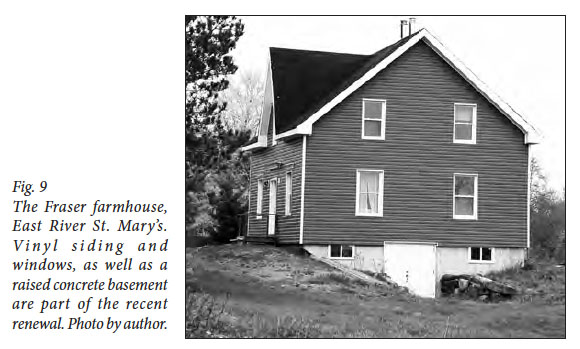 Display large image of Figure 9
Display large image of Figure 9
The Commercial Farm
16 The Archibald family has been farming in St. Mary’s since the 1830s. Their commercial dairy farm, according to Ian Archibald, manages the land that once consisted of the livelihood of more than thirty families along the St. Mary’s River. Archibald Dairy is the only farm in St. Mary’s that still operates on a full commercial scale, and is among the most successful in eastern Nova Scotia, milking around 175 cows twice daily. Brothers Ian and Dale, and their retired father Robert, have little time for what they see as the sentimentality of old buildings. The farmhouse, built around 1915, has undergone so many alterations that the original form is almost indistinguishable (Fig. 10). The farm transitioned from small scale to an extensive commercial operation gradually, which is reflected in the evolution and ultimate demise of the 19th-century timber-frame barn. In 1943, the barn was raised up on concrete, and the cattle were put underneath. Various linhays (sheds) were added for mechanical milk processing and storage equipment. “A lean-to on a lean-to on a lean-to,” Ian jokes. Eventually, that barn was demolished in 1983, after the family built a steel framed barn in 1981, on a plan received from the Dept. of Agriculture. “Didn’t need it,” Robert bluntly remarks on the fate of the timber-framed structure. In 2005, a free stall barn was built, the most innovative design for dairying operations today. The herring bone style milking parlour was added in 2008 (Fig. 11 and 12). All of these new buildings were important moments for the farm because it meant that although hundreds of other family farms across the province were stopping their production of milk, Archibald Dairy was still in operation.
 Display large image of Figure 10
Display large image of Figure 10
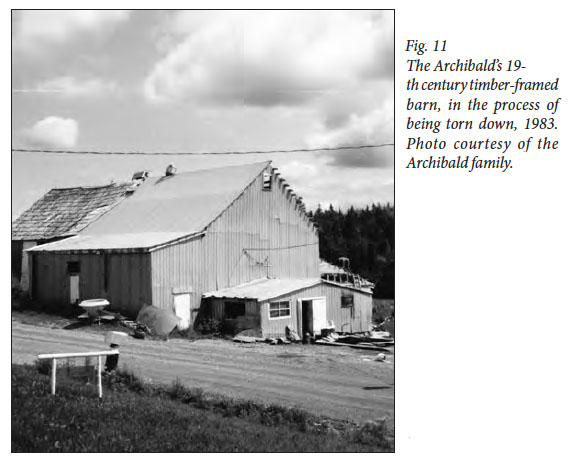 Display large image of Figure 11
Display large image of Figure 11
17 It’s probable that the old farmhouse will also be demolished after Robert passes, because his sons and grandchildren will have no use for it. The house, built by Robert’s father, Merritt, in 1915, certainly replaced an older one that was turned into a hen house before it was demolished. Robert explains to me that, “If we’re not making that litre of milk efficient, we’re not here.” The farm is continually seeking new ways to make their business more innovative in the face of stiff competition and increasing production costs, and this includes strategies for field maintenance and manure disposal, as well as building design. There is no room for maintaining old buildings: “I don’t think a person can live that way. I think you have to change, or you don’t stay,” Robert tells me. Staying is what is important to the Archibald family, being here is what matters and this entails removing old barns and building new ones. The removal of the old and the building of new was the only avenue that would ensure progress and success for the farm for continued generations and the farm will continue to provide a living for Robert’s grandchildren. What the Archibald’s define as heritage, then, is sense of place and occupational continuity—that the farm is maintained as a working, active space. Heritage is not defined in the buildings. Whereas Frankie Cumminger’s farm heritage is a past story encapsulated in the decaying buildings, the Archibald farm heritage is devoid of old buildings, and is instead characterized by the practices of their on-going farm work. Indeed, what matters to the Archibald’s is that they actively contribute to their community and local agricultural economy, that they remain on their land, and that their knowledge of farming and animal husbandry, of their fields and woodlots—the intangible knowledge of their farm that ties them to place—is sustained.
Toward New Conceptions of Built Heritage? Lessons from ICH
18 How should we conceptualize built heritage? Historic buildings in St. Mary’s are assigned meanings that subvert the authorized heritage discourse and attest, rather, to the fluidity of heritage, and to the value of the intangible contexts of buildings. Understandings of intangible cultural heritage that engage with the tangible usually involve the knowledge and skills to produce traditional crafts like architecture, but not the material products themselves. However, ICH focuses on more fundamental actions and attitudes. And the UNESCO convention on ICH acknowledges that intangible heritage “thrives on its basis in communities” and that it is dynamic, or “traditional, contemporary and living at the same time” (UNESCO a) and must be “continuously recreated and transmitted from one generation to another” (UNESCO b). The intangible heritage of historic architecture can certainly be more than just traditional carpentry skills. Tangible things like buildings can hold a myriad of intangible values and contexts, as the case studies of St. Mary’s architecture indicate.
19 There are at least three lessons from ICH that we, as heritage practitioners and scholars, can consider in our thinking about built heritage—lessons that force us to question our own authorized heritage assumptions. The first is that “vernacular conservation” (as outlined above in Table 1) is an emic cultural attitude concerning building renovation, maintenance and change. As a “way of doing,” it is therefore a component of the intangible heritage of a building. Gerald Pocius (2008) has argued in the context of Newfoundland that houses are governed by the intangible value of “build it modern, then over the years renovate it, maintain it, change it” (2). Indeed, repeatedly altering and renewing houses—even to the extreme of cutting down a roofline from gable to gambrel in order to accommodate the latest architectural fashion—is an attitude prevalent across Newfoundland culture over time (1987; 1991: 94-97). If my examples from St. Mary’s are any indication, the same can be argued for rural communities across Nova Scotia. In St. Mary’s, the continual updating and modernization of houses keep them relevant for contemporary life, for the next generation—yet another crucial component of ICH.
20 The UNESCO ICH convention suggests that intangible heritage must evolve and change. The form of the cultural product itself does not matter, but rather the active continuity of the tradition within the community. Should buildings evolve and change as much as established forms of ICH, like song, dance, and ritual? I would argue that we can also apply this fluid perspective for built landscapes, as we must ultimately understand that change in building fabric and in building use can help keep communities sustainable. People must live in living houses.
21 Second, stories and memories matter when looking at buildings. Often the meaning of a building transcends the physical and reaches into the realm of the highly personal, of subjective experience, or of family identity and belonging. What dimensions of meaning are we missing out on when we just see historic buildings as wood and stone? Unfortunately, built heritage specialists are well-trained in building documentation and analysis, but they seldom know how to illicit stories and experiences through oral history interviewing or participant observation. This requires a whole different set of professional skills that are ethnographic in nature. We need to reconsider the hierarchy of value in the built heritage world, and recognize that historic fabric, authenticity, and aesthetics are just a few of many dimensions of significance. More ethnographic perspectives in the realm of historic preservation could foster alternative discourses of heritage. Of course, exploring narrative and memory surrounding buildings of the contemporary past is less challenging than looking at buildings from historic time periods, when the people involved are long gone. Considering the intangible when memories no longer exist is not impossible, however. For example, when we focus on the social function and use of buildings in our historical explorations, we can at least get some sense of the lived experience of people, and of their relationship with buildings.
22 Finally, we can ask ourselves whether old buildings should die. Until the Victorian era, historic preservation was a relatively unknown phenomenon as humans renovated, renewed, and removed buildings with little thought of their historical merit or of preservation for the sake of posterity. Buildings were not viewed as legacies. If forms of heritage are considered as living bodies, as according to the ICH convention, then heritage forms must follow a life cycle where “some elements are likely to disappear, after having given birth to new forms of expressions” (UNESCO b). If a building is no longer considered relevant or meaningful—either economically or socially—for the family or community, should it be preserved? When we view buildings as part of a much wider cultural landscape, we can see that they are only one small part of the sustained experience of dwelling in place and community. Traditional knowledge of a landscape and ways of doing and living, such as farming, all require specific buildings. But for farm families like the Archibald’s, it is important that fresh forms emerge on the landscape that serve a similar purpose, but in new and current ways so that they may continue in their community as farmers.
Conclusion
23 Jamie Cunningham may alter his farmhouse windows in a way that offends my authorized heritage discourse aesthetic, but I realize that replacing his historic window is a deliberate act of vernacular conservation that allows him to live in his family home, within his community, the way that he wants to. Indeed, Jamie is one of the most valued neighbours in East River St. Mary’s. He delivers food to the sick, he mows lawns, pays visits to the elderly, and his presence has contributed to the overall energy and viability of his small community in innumerable ways—a community that, like most places in rural Nova Scotia, faces multiple challenges to its continued existence.
24 The Gunn family may tear down their derelict farmhouse, but a new house has been built on the hill above it, and the family name and presence continues in the community. Does the destruction of the old house matter if the family builds a new one on the same farmland? Frankie’s barn and farmhouse are in a state of decay, but the buildings are preserved through his memory and experience. The Archibald’s work their farmland, and continue in the occupation that they have held since the 1830s. The 19th-century timber-framed barn no longer exists, but there is another, newer barn serving the same purpose of sheltering and milking cows. The act of doing, of working the farm as occupational identity becomes their expression of heritage.
25 What is important, in the end, is that the landscape of St. Mary’s is a living one. Social relationships judged by community values are the most important notions of heritage. Church suppers, helping your neighbour, contributing to the economy, volunteering at the fire hall—all become crucial to the vitality of the community more than a landscape of preserved buildings (Fig. 13). Perhaps the best way to describe St. Mary’s is a cultural ambivalence toward the built landscape. Old buildings are valued; the fact that people bother to maintain them at all speaks to this, but resident’s motivations are driven by pragmatism and the realities of their socioeconomic status that does not permit them to indulge in the expensive, often elitist world of heritage carpentry and restoration.
 Display large image of Figure 13
Display large image of Figure 13
26 Architecture is multi-vocal, and the multiple iterations of buildings ultimately speak to a series of strategies that Nova Scotians utilize in order to contend with contemporary challenges they face in rural living. Essentially, how to stay in your place. Built heritage, then, becomes redefined in its notion in the context of the everyday landscape of St. Mary’s. Heritage is not based on the fabric of the building. In fact, most locals do not consider loaded terms like authenticity, nor do they consider in-kind replacement or the visual compatibility of their changes to the historic structure. Frequently, destruction is chosen over stabilization. Rather, what defines heritage are experiences and memories, the ability to dwell and continue within your home community, to be a good neighbour, to take pride in the sense of place that comes from living on one farm for multiple generations. The replacement of wood windows with vinyl, stone cellars with concrete are strategies that ensure that houses and barns remain on the landscape, but it also ensures that communities are sustainable. Continuity, more than buildings, perhaps, is the prime index of landscapes, and heritage for the people of St. Mary’s is deeply rooted in the intangible, in spirit of place and community living.
